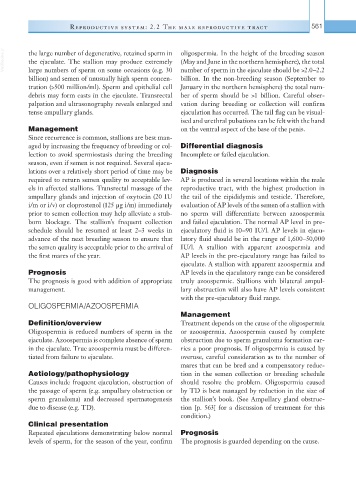Page 586 - Equine Clinical Medicine, Surgery and Reproduction, 2nd Edition
P. 586
Reproductive system: 2.2 The male reproductive tr act 561
VetBooks.ir the large number of degenerative, retained sperm in oligospermia. In the height of the breeding season
(May and June in the northern hemisphere), the total
the ejaculate. The stallion may produce extremely
large numbers of sperm on some occasions (e.g. 30
billion. In the non-breeding season (September to
billion) and semen of unusually high sperm concen- number of sperm in the ejaculate should be >2.0–2.2
tration (>500 million/ml). Sperm and epithelial cell January in the northern hemisphere) the total num-
debris may form casts in the ejaculate. Transrectal ber of sperm should be >1 billion. Careful obser-
palpation and ultrasonography reveals enlarged and vation during breeding or collection will confirm
tense ampullary glands. ejaculation has occurred. The tail flag can be visual-
ised and urethral pulsations can be felt with the hand
Management on the ventral aspect of the base of the penis.
Since recurrence is common, stallions are best man-
aged by increasing the frequency of breeding or col- Differential diagnosis
lection to avoid spermiostasis during the breeding Incomplete or failed ejaculation.
season, even if semen is not required. Several ejacu-
lations over a relatively short period of time may be Diagnosis
required to return semen quality to acceptable lev- AP is produced in several locations within the male
els in affected stallions. Transrectal massage of the reproductive tract, with the highest production in
ampullary glands and injection of oxytocin (20 IU the tail of the eipididymis and testicle. Therefore,
i/m or i/v) or cloprostenol (125 µg i/m) immediately evaluation of AP levels of the semen of a stallion with
prior to semen collection may help alleviate a stub- no sperm will differentiate between azoospermia
born blockage. The stallion’s frequent collection and failed ejaculation. The normal AP level in pre-
schedule should be resumed at least 2–3 weeks in ejaculatory fluid is 10–90 IU/l. AP levels in ejacu-
advance of the next breeding season to ensure that latory fluid should be in the range of 1,600–50,000
the semen quality is acceptable prior to the arrival of IU/l. A stallion with apparent azoospermia and
the first mares of the year. AP levels in the pre-ejaculatory range has failed to
ejaculate. A stallion with apparent azoospermia and
Prognosis AP levels in the ejaculatory range can be considered
The prognosis is good with addition of appropriate truly azoospermic. Stallions with bilateral ampul-
management. lary obstruction will also have AP levels consistent
with the pre-ejaculatory fluid range.
OLIGOSPERMIA/AZOOSPERMIA
Management
Definition/overview Treatment depends on the cause of the oligospermia
Oligospermia is reduced numbers of sperm in the or azoospermia. Azoospermia caused by complete
ejaculate. Azoospermia is complete absence of sperm obstruction due to sperm granuloma formation car-
in the ejaculate. True azoospermia must be differen- ries a poor prognosis. If oligospermia is caused by
tiated from failure to ejaculate. overuse, careful consideration as to the number of
mares that can be bred and a compensatory reduc-
Aetiology/pathophysiology tion in the semen collection or breeding schedule
Causes include frequent ejaculation, obstruction of should resolve the problem. Oligospermia caused
the passage of sperm (e.g. ampullary obstruction or by TD is best managed by reduction in the size of
sperm granuloma) and decreased spermatogenesis the stallion’s book. (See Ampullary gland obstruc-
due to disease (e.g. TD). tion [p. 563] for a discussion of treatment for this
condition.)
Clinical presentation
Repeated ejaculations demonstrating below normal Prognosis
levels of sperm, for the season of the year, confirm The prognosis is guarded depending on the cause.

